How Accreditation Standards Vary by Country
Accreditation in healthcare ensures that hospitals and clinics meet specific quality and safety standards. But these standards differ across countries. Here's what you need to know:
- Why It Matters: Accredited facilities follow strict guidelines to ensure patient safety and high-quality care. This is especially important if you're considering medical treatment abroad.
- Global Accreditation Bodies: Major organizations like Joint Commission International (JCI), Accreditation Canada, Australian Council on Healthcare Standards International (ACHSI), and others set these standards. Each has unique methods and areas of focus.
- What to Look For: JCI is the most globally recognized, accrediting over 1,000 facilities worldwide. Others, like GHA and TEMOS, focus on medical tourism and cultural sensitivity.
Quick Comparison of Major Accreditation Bodies
| Accreditation Body | Scope (Countries) | Focus Areas | Evaluation Frequency |
|---|---|---|---|
| Joint Commission International (JCI) | 70+ | Patient safety, quality care | Every 3 years |
| Accreditation Canada | 40+ | System-wide evaluations | Continuous improvement |
| ACHSI | 25+ | Patient-centered care, improvement | Every 4 years |
| Global Healthcare Accreditation (GHA) | Multiple continents | Medical tourism, patient experience | Tailored timelines |
| TEMOS | 75+ clients | Local customs, international patients | Every 3 years |
Key Takeaway
Accreditation ensures better care and safety. Always verify a facility’s accreditation status before seeking treatment abroad. Look for certifications from trusted organizations like JCI, Accreditation Canada, or GHA. Platforms like Explore Medical Tourism can help you find accredited providers worldwide.
Global Healthcare Accreditation: Standards and Bodies by Country | JCI | Healthcare Accreditation |
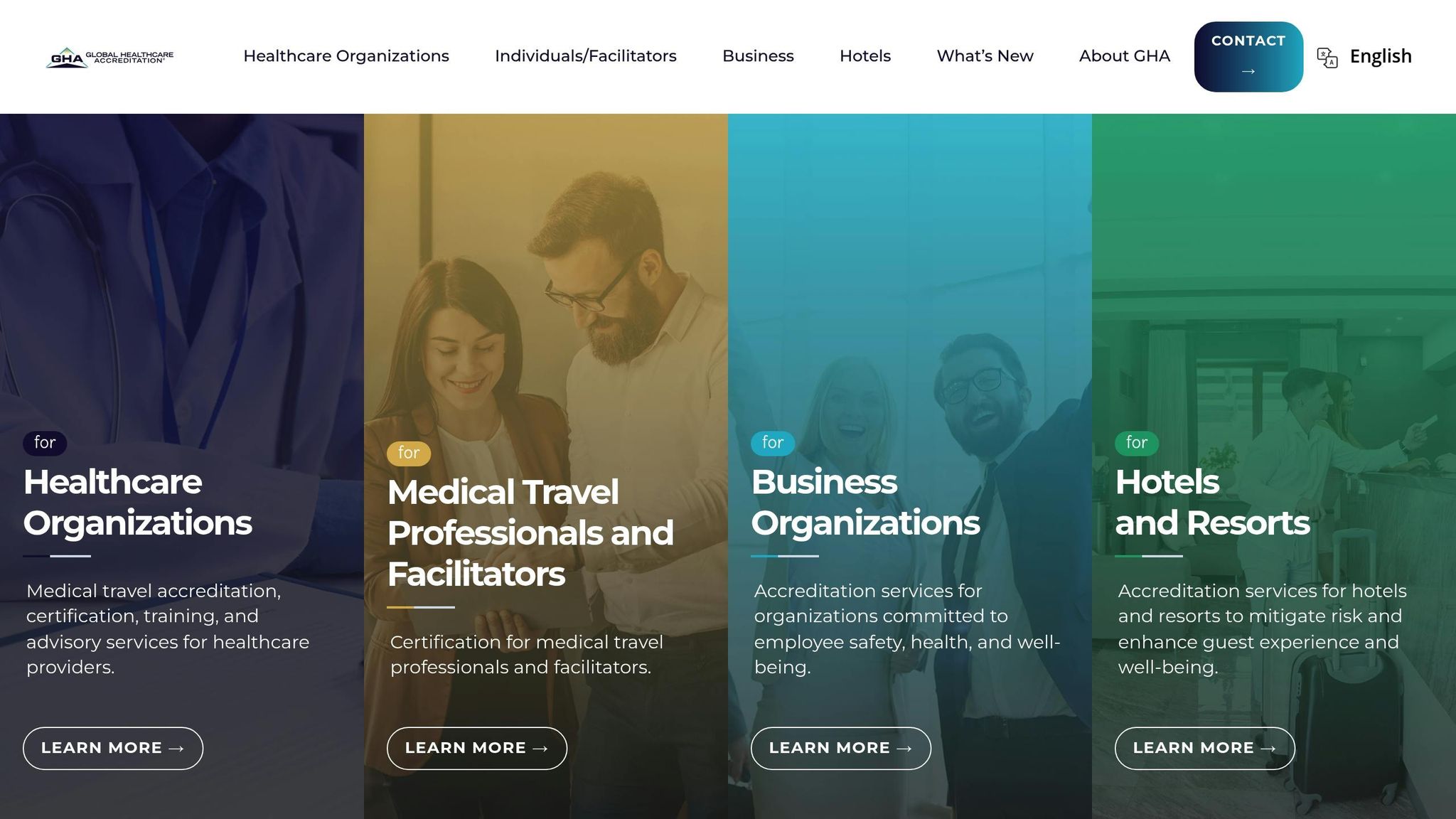
1. Joint Commission International (JCI)
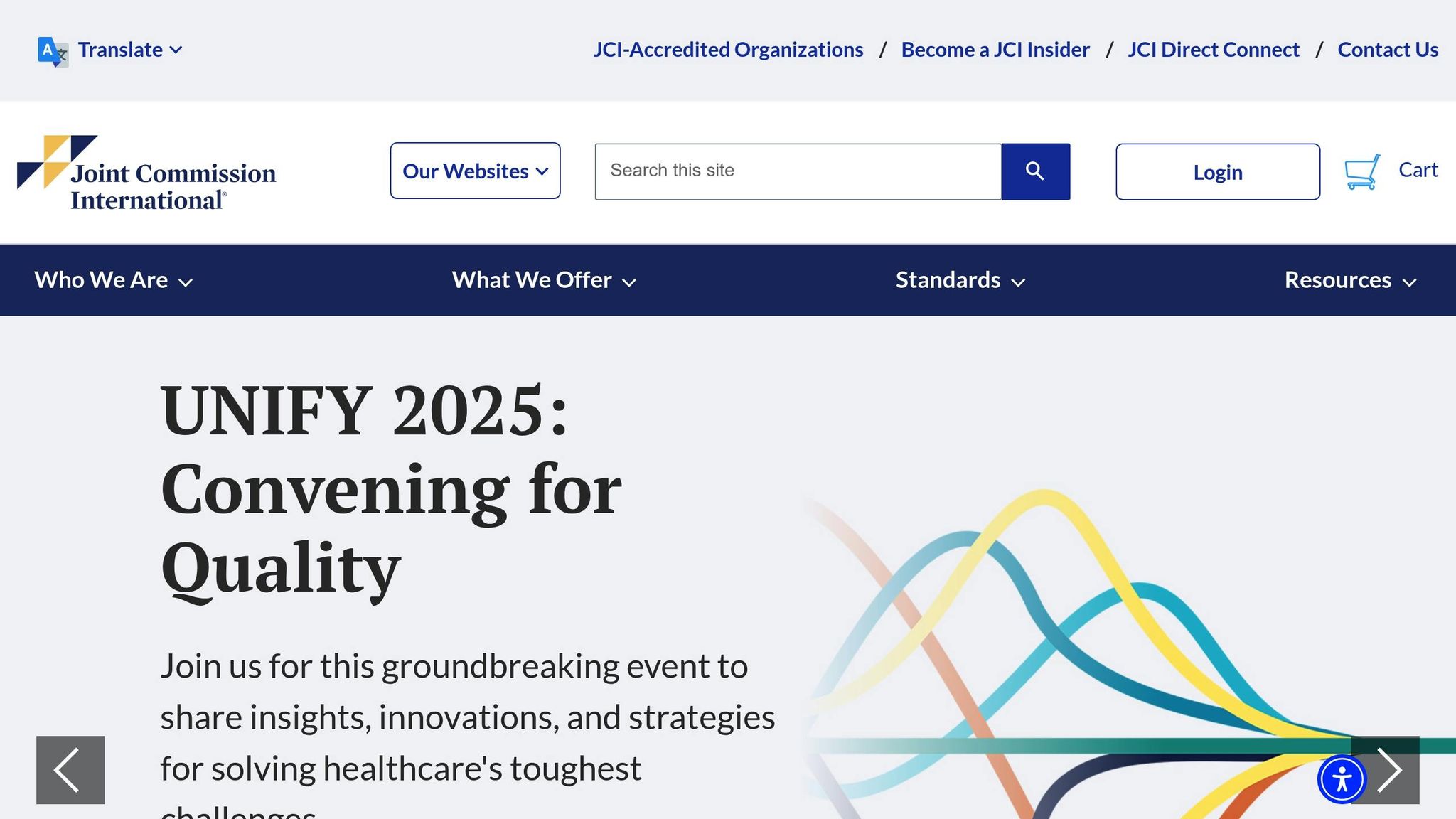
Joint Commission International (JCI) is widely regarded as the leading healthcare accreditation organization in the world. Its Gold Seal of Approval is recognized globally as a symbol of excellence in healthcare quality and patient safety. By setting rigorous standards, JCI helps patients identify top-tier international healthcare providers.
Scope and Global Presence
JCI operates across more than 70 countries, including regions in Asia, Europe, the Middle East, Africa, and Latin America [2]. It collaborates with over 23,000 healthcare organizations and programs worldwide, supported by a team of more than 600 experts. To date, JCI has accredited and certified over 1,000 healthcare programs [1][2].
The global reach of JCI-accredited facilities underscores its reputation. Recent additions to its roster include hospitals and clinics in Armenia, Jordan, and the United Arab Emirates.
Focus on Quality and Patient Safety
JCI’s standards are designed to be both measurable and practical, ensuring that healthcare organizations can implement them regardless of their location [3]. Its mission is clear: to support the highest levels of healthcare quality and patient safety worldwide [2][1].
The 8th edition of its Accreditation Standards introduced a new Patient Safety Chapter, with specific provisions for vulnerable patient populations. This revision also streamlined the requirements, reducing them by about 10-15% to focus on criteria that add the most value [4]. Andrew Rosen, Vice President of Joint Commission International, elaborates:
"Drawing upon the latest evidence and insights from our global network of JCI-accredited healthcare organizations and patient safety experts, we've reduced the number of standards by approximately 10-15%. By consolidating requirements, removing duplicates and focusing on more value-added criteria, we intend to help advance patient safety and improve the overall care experience." [4]
Healthcare professionals often praise the accreditation process for its positive impact. Alex Lan, President and CEO of Hong Kong Adventist Hospitals, shared:
"JCI accreditation is one of the best team-building exercises - the teamwork and unity that was required during the accreditation process was excellent training for all staff and has greatly enhanced overall coordination and communication skills and processes across all departments at the hospital. The JCI accreditation process is very comprehensive and provided the hospital with many learning opportunities." [2]
JCI’s commitment to quality is further reinforced by its thorough and ongoing evaluation practices.
Rigorous Evaluation and Monitoring
JCI’s evaluation process prioritizes continuous improvement over one-time assessments. Accredited facilities are subject to unannounced surveys at least once every 36 months [5]. These reviews include patient record analysis, staff interviews, and direct observations [5]. To maintain compliance between surveys, organizations use self-assessment tools, ensuring consistent adherence to JCI standards [5].
This meticulous approach also aligns with structured timelines and costs for accreditation.
Accreditation Timelines and Costs
JCI accreditation is awarded for a fixed period - three years for most programs and two years for laboratory accreditation [5]. Surveyors are trained to adapt the accreditation process to align with specific legal, religious, and cultural considerations in each country [1].
Healthcare administrators frequently highlight the benefits of JCI accreditation, noting how it enhances community trust, builds a culture of patient safety, and provides a competitive edge in the healthcare market.
2. Accreditation Canada
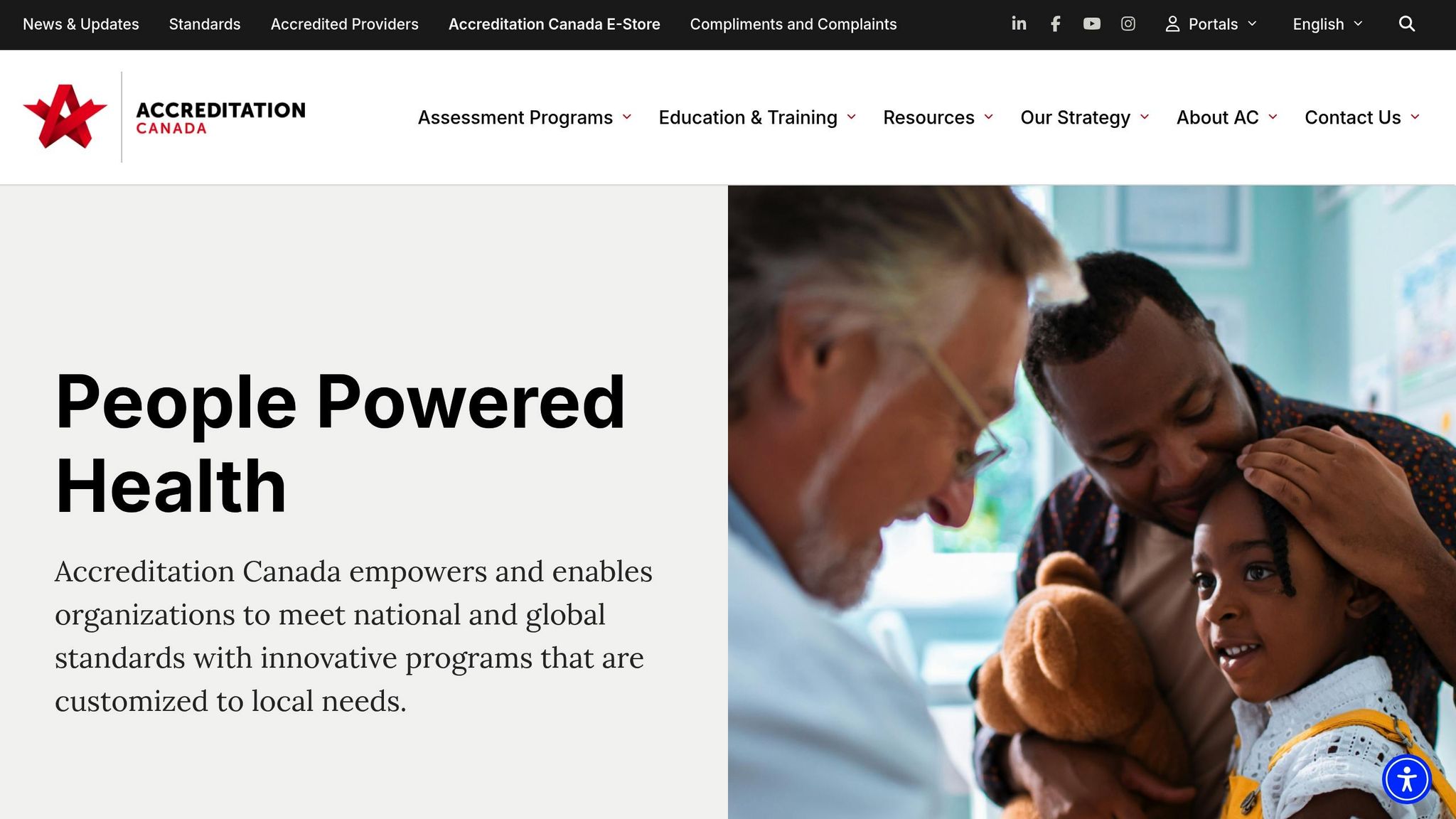
Accreditation Canada has been a leader in setting healthcare quality standards since 1958 and expanded its reach internationally in 1998. Below, we explore their global influence, quality measures, and the unique approach they bring to healthcare accreditation.
Scope and Global Reach
Accreditation Canada’s services now extend to over 12,500 sites across more than 40 countries, accrediting thousands of organizations worldwide [6][7][8].
In 2002, the International Society for Quality in Health Care (ISQua) acknowledged Accreditation Canada's global impact, noting that "one-third of health care standards worldwide have taken their lead from Accreditation Canada" [6]. Their international presence spans regions such as Europe, the Gulf, Latin America, and the Caribbean [6].
Core Standards for Quality and Safety
At the heart of Accreditation Canada’s work is its Qmentum program, which evaluates healthcare organizations based on eight key dimensions: population focus, accessibility, safety, work life, client-centered services, continuity of services, effectiveness, and efficiency [7].
The organization has developed close to 100 standard sets, ensuring that their criteria address the diverse needs of different care sectors and local contexts [7]. This adaptability allows them to provide accreditation tailored to the specific requirements of healthcare organizations worldwide.
Accreditation Canada assesses healthcare facilities using standards from respected bodies like the Health Standards Organization (HSO) and the International Standards Organization (ISO) [9]. Unlike some accreditation bodies that focus on individual departments, Accreditation Canada often evaluates organizations as whole systems. This approach fosters accountability and ensures that all services within an organization are integrated and aligned [7].
Evaluation and Monitoring Approach
Their approach to evaluation is partnership-driven rather than audit-focused, encouraging staff to engage in self-assessment and ongoing quality improvement [8].
The process begins with a self-assessment phase, where staff evaluate their facility’s performance against established standards. Using questionnaires, they identify strengths and prioritize areas for improvement, creating actionable plans to address gaps [12]. This method helps organizations weave accreditation principles into their daily operations, emphasizing priority setting, planning, and monitoring results [12].
A standout feature of Accreditation Canada’s process is the inclusion of patient perspectives. Heather Thiessen, a Patient Surveyor, highlights the importance of this:
"It's not about just checking a box to say that you're including a patient and their family in the work that you're doing. It's about finding meaningful engagement and acknowledging lived experience expertise, which is such a gift to organizations. This valuable feedback helps improve quality and safety for future patients and families." [11]
After the self-assessment, trained surveyors carry out in-depth evaluations of the organization’s programs and services, measuring them against rigorous standards of excellence [12]. The focus is on continuous improvement, rather than merely meeting compliance benchmarks. This ensures that organizations remain committed to enhancing care quality and patient safety over time [11].
Additionally, Accreditation Canada is moving away from traditional data reporting requirements. Instead, they now emphasize helping healthcare organizations use their own data to drive quality improvements [7]. This shift underscores their dedication to practical, results-oriented accreditation that benefits both healthcare providers and patients.
3. Australian Council on Healthcare Standards International (ACHSI)
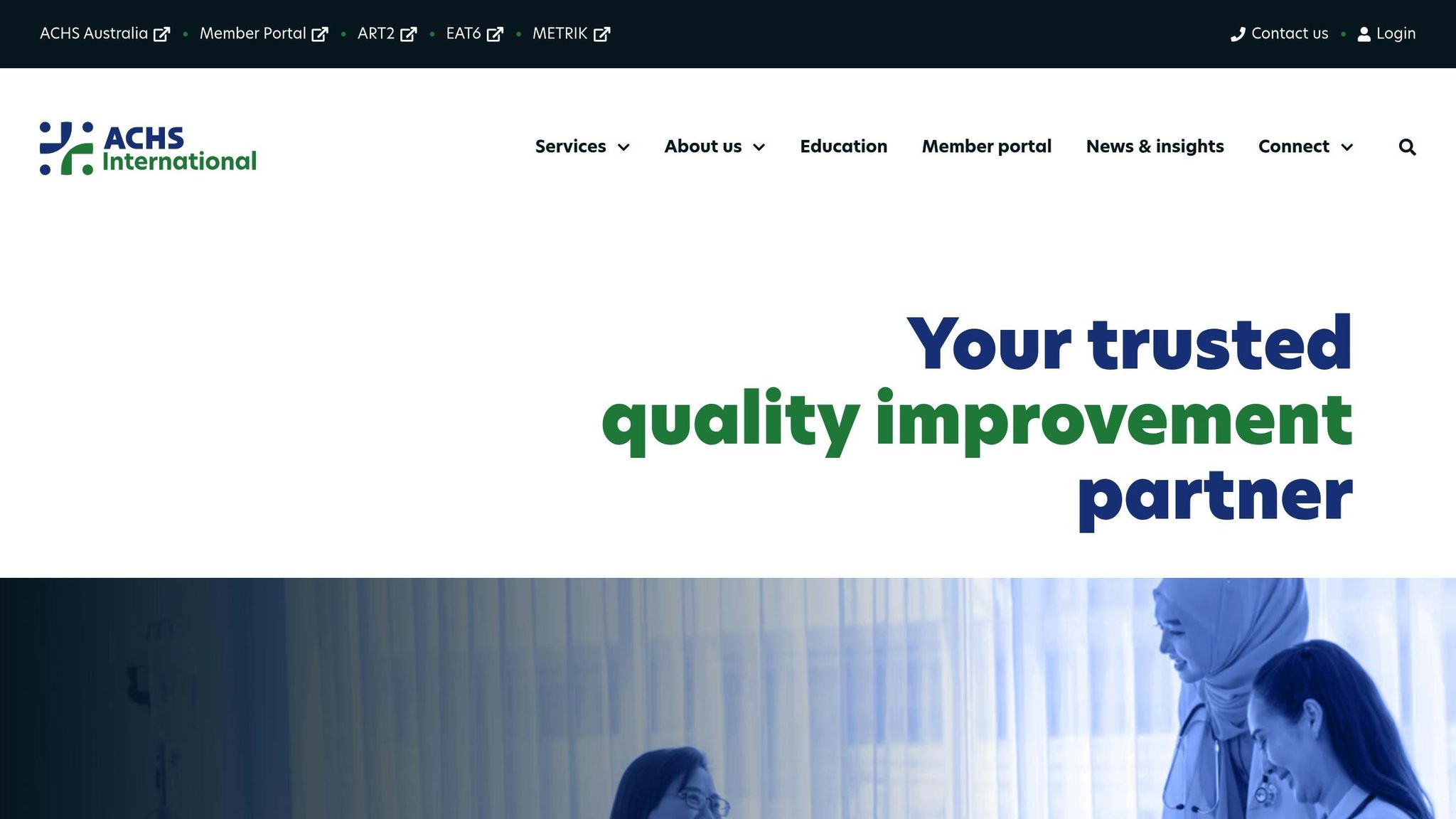
The Australian Council on Healthcare Standards International (ACHSI) brings over 50 years of experience to the table, offering an accreditation model that prioritizes ongoing improvement rather than simple compliance checks. Operating in more than 25 countries and serving over 1,600 members globally, ACHSI plays a pivotal role in shaping healthcare quality worldwide [26,28]. This section continues our examination of international accreditation systems, focusing on how these standards influence patient care across borders.
Louise Cuskelly, Executive Director of ACHS International, underscores the value of this accreditation and the global recognition of Australian healthcare standards:
"Accreditation to Australian standards is a prestigious achievement because we have a world-class health system. We're ranked third in the world for our healthcare system and first for healthcare outcomes." [14]
This acknowledgment reflects the trust in Australian standards, which emphasize care quality and safety while aligning with broader trends in patient-centered accreditation practices.
Core Quality and Safety Standards
At the heart of ACHSI's accreditation framework lies the EQuIP standards, endorsed by the ISQua External Evaluation Association (IEEA) [27,28]. These standards are built around patient-centered care, continuous improvement, and measurable outcomes.
ACHSI adopts a tailored approach, offering Foundation and Recognition assessment phases for organizations just starting their quality improvement journey [14]. For those aiming to go further, advanced modules are available. The organization also uses its METRIK data system to benchmark performance and provides training and consultancy services to support ongoing development [14].
Evaluation and Monitoring Process
Much like JCI and Accreditation Canada, ACHSI focuses on both external evaluations and internal growth. Healthcare organizations are assessed against the EQuIP standards, with expert-led reviews identifying areas for improvement and structured plans to address any gaps [27,32,33]. ACHSI offers flexible options, including integrated or stand-alone assessments, allowing organizations to choose the model that suits their needs [16]. Additionally, the EQuIP standards undergo a thorough review every four years, with input from expert working groups to ensure they remain relevant and effective [13].
Louise Cuskelly highlights what sets ACHSI apart:
"Our accreditation model offers more service and more support for members. We have a strong focus on quality improvement and learning which is valued by our members. Because of this, healthcare providers are increasingly turning to ACHSI as they value our supportive approach. We are seeing growth in all the regions we work in." [14]
Maintaining ACHSI accreditation requires organizations to demonstrate ongoing improvement and adherence to established standards, ensuring that quality enhancement remains a continuous process rather than a one-time achievement.
For patients, this accreditation offers peace of mind:
"It gives patients a high level of assurance that the provider meets exceptionally high standards of care, safety and governance. This makes a difference in places like Bali that attract large numbers of international tourists, or for providers in the medical tourism market." [14]
4. QHA Trent Accreditation (UK)
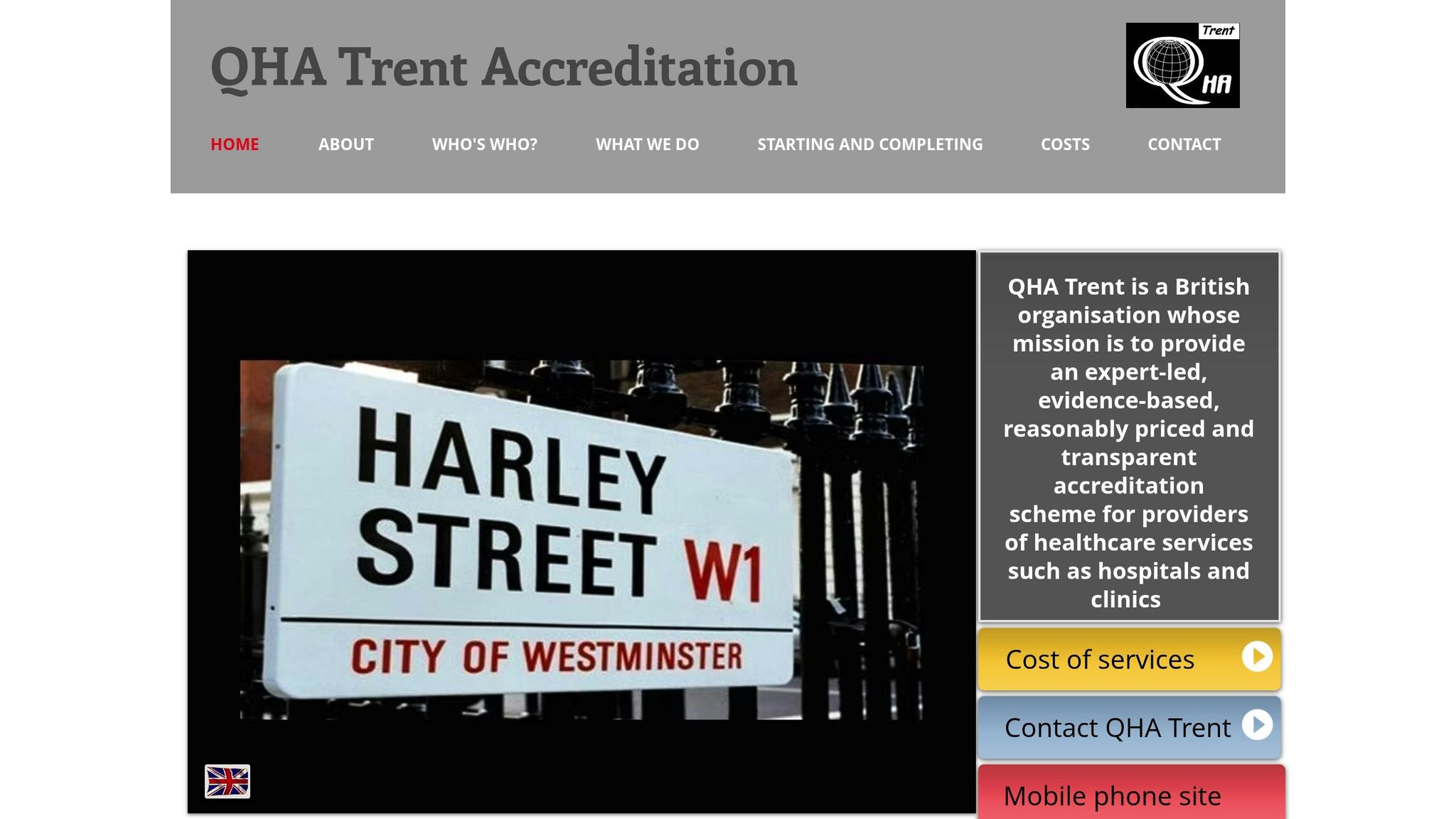
QHA Trent brings a distinct UK perspective to healthcare accreditation, emphasizing quick evaluations and ongoing improvement. Originally rooted in the NHS's clinical governance framework, QHA Trent became an independent organization in 2010 after the original program closed. Its experienced surveyors shifted focus to serve an international audience, building on their expertise [17][21].
Scope and Geographic Reach
QHA Trent operates both in the UK and internationally. Notably, it was the first organization to accredit a hospital in Asia, starting with Hong Kong in 2000. By 1999, it had already accredited twelve private hospitals in Hong Kong. Liz Brownhill, Chief Operating Officer of QHA-Trent, explained this shift:
"It was clear that the method worked very well with large hospitals outside the UK. Eventually all the work was overseas so in 2010, it was agreed it was no longer appropriate for it to continue within the [UK] National Health Service." [21]
The organization prides itself on its efficiency, completing the accreditation process in just three months [18].
Quality and Safety Standards
QHA Trent’s standards are deeply influenced by the UK’s National Health Service clinical governance principles. These standards are built on UK guidelines, advice from Royal Colleges, and global best practices, ensuring a solid framework for assessing healthcare quality [19].
What makes QHA Trent stand out is its focus on more than just meeting minimum requirements. The organization collaborates closely with healthcare providers to enhance care for both local patients and those seeking medical treatment from abroad. Its standards are cross-referenced with expert guidance from the UK and Europe, ensuring they remain both credible and globally relevant [18][19][20].
Evaluation and Monitoring
QHA Trent’s on-site evaluations are thorough, with expert teams assessing over 1,000 criteria through inspections, record reviews, and interviews. After the survey, the Independent Accreditation Awards Panel meets with the provider's management to determine the outcome: full accreditation, conditional approval, or no accreditation [22].
Accreditation typically lasts two years, though some providers may qualify for up to three years [22][23]. This process isn’t just about meeting standards - it’s about identifying strengths and areas for growth. Surveyors work collaboratively with providers, creating an environment focused on improvement [23].
As the organization explains:
"The accreditation process also provides opportunities for the healthcare facility to develop new high-quality and patient-safe policies, practices and procedures." [22]
sbb-itb-3922076
5. Global Healthcare Accreditation (GHA)
Global Healthcare Accreditation (GHA) stands out in the world of international healthcare by concentrating on improving the medical travel experience. Rather than following the traditional accreditation model, GHA zeroes in on the unique challenges faced by international patients, offering specialized standards tailored to medical tourism. They aim to enhance the patient journey while bridging the gaps often encountered in cross-border healthcare.
Scope and Geographic Reach
GHA’s influence spans multiple continents, accrediting healthcare providers in countries like the United States, Mexico, Croatia, and Thailand [27]. Their services go beyond hospital accreditation, extending into certification, training, and advisory solutions for healthcare organizations and professionals in medical travel [24]. They’ve even broadened their programs to cover the full care continuum, including telehealth services and infection prevention protocols, ensuring a comprehensive approach to modern medical tourism [24][25].
One example of GHA’s impact is Vejthani Hospital in Bangkok, Thailand, which earned a three-year "Accreditation with Excellence" from GHA in May 2018. Dr. Soucksakit, the hospital’s CEO, shared:
"GHA accreditation was the missing piece which affirms our pride to be an exceptional care provider to all medical travelers along their journey" [27].
Quality and Safety Standards
GHA’s standards, accredited by ISQua EEA, are internationally recognized for their credibility [25][26]. These standards build on existing safety protocols but are specifically refined for medical travel. GHA’s evaluation focuses on three main areas: the Patient Experience, Sustainable Business Processes, and Patient-Focused Clinical Processes [28]. Unlike other accreditation programs that assess the entire healthcare organization, GHA hones in on the medical travel operations, addressing aspects that are critical to international patient care [25][28].
Dr. Nizar Zein, Chairman of Global Patient Services at Cleveland Clinic, explained their decision to work with GHA:
"We chose Global Healthcare Accreditation as it reviews those sustainable business processes and practices related to medical travel that have helped us identify areas of opportunity to enhance the patient experience and improve operational performance" [25].
Cultural competency also plays a key role in GHA’s framework. Karen Timmons, CEO of the Global Healthcare Accreditation Program, highlighted this focus:
"GHA seeks to assure that the patient is actively engaged and that the organization is proactive in managing cultural sensitivities and communication at each touch point along this Medical Travel Care Continuum" [27].
Evaluation and Monitoring Process
GHA’s evaluation isn’t just an inspection - it’s a learning experience. Their process helps healthcare providers identify practical ways to improve medical travel operations. Jadranka Primorac, COO of St. Catherine Specialty Hospital in Croatia, shared her perspective:
"The GHA accreditation process taught us many new strategies to improve the patient experience for medical travelers and refine our operational procedures" [25].
Rather than duplicating existing clinical accreditations, GHA focuses exclusively on medical travel operations. This specialized approach allows healthcare providers to retain their current quality certifications while enhancing their capabilities in medical tourism.
For American patients exploring healthcare options abroad, GHA accreditation provides an added layer of confidence. It ensures that facilities are prepared to address the specific needs of international patients, including overcoming language barriers, navigating cultural differences, and coordinating care with providers back home.
6. TEMOS
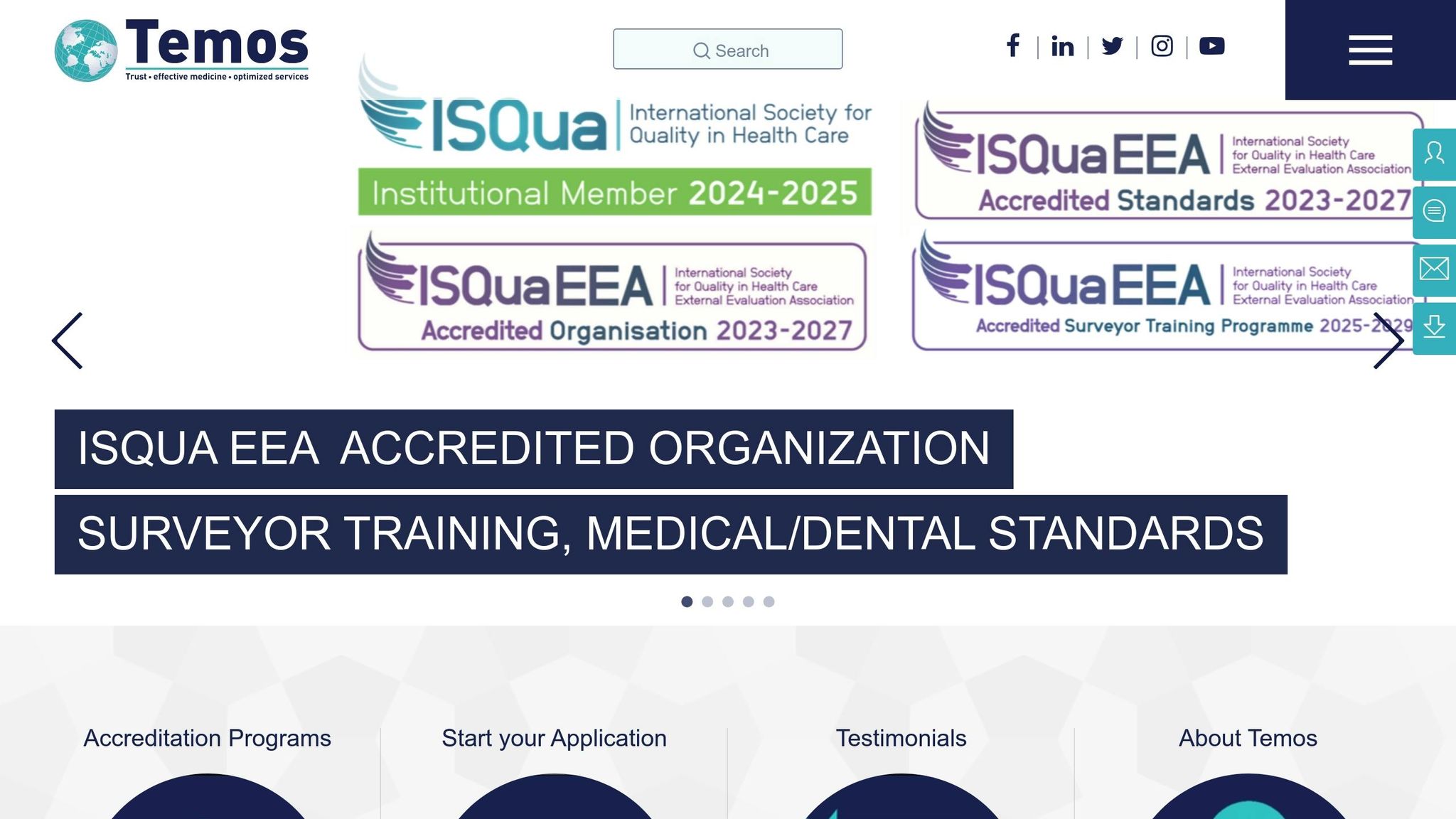
TEMOS International Healthcare Accreditation, established in 2010, provides tailored accreditation programs that combine clinical excellence with sensitivity to local customs and healthcare practices. Below, we explore TEMOS' global influence, its focus on quality standards, and its distinctive evaluation process.
Scope and Geographic Influence
TEMOS accredits over 80 healthcare providers and medical travel coordinators worldwide, serving more than 75 international clients [29][30]. Their network includes hospitals, clinics, dental centers, IVF facilities, rehabilitation centers, eye clinics, and medical travel coordinators across regions like the United States and the Philippines.
Through strategic partnerships, TEMOS extends its reach across continents. For example, Medical Tourism Training exclusively represents TEMOS in the United States, Mexico, Central and South America, and the Caribbean [29]. This collaborative approach ensures that TEMOS maintains regional expertise while upholding consistent quality standards globally.
Elizabeth Ziemba, JD, MPH, President of Medical Tourism Training and TEMOS Representative, highlights the organization's mission:
"Temos Worldwide offers accreditation that addresses the particular needs of healthcare providers who serve medical tourists" [29].
Core Quality and Safety Standards
What sets TEMOS apart is its ability to align accreditation standards with local cultural practices [10]. Its framework focuses on key areas such as patient safety, care quality, ethics, patient-centered care, and data protection [10]. These standards emphasize access, continuity, and efficiency in patient care, incorporating forward-thinking requirements that aim to improve healthcare delivery [10].
TEMOS also offers flexible accreditation programs tailored to different types of healthcare facilities. This allows hospitals and clinics to adapt their services for international patients by meeting optional standards [10]. The organization prioritizes both clinical and non-clinical outcomes, with an emphasis on sustainable practices and ongoing quality improvement [10]. Notably, more than 80% of TEMOS-accredited facilities are hospitals, underscoring its strong influence in this sector [10]. In 2019 alone, 88 healthcare organizations across 29 countries achieved TEMOS accreditation, demonstrating its global impact [10].
Evaluation and Monitoring Process
TEMOS follows a collaborative, three-step evaluation process. Dr. Claudia Mika, Founder and CEO of TEMOS International Healthcare Accreditation, explains:
"It is a cooperative, voluntary process between the accreditation organization and the clinic or hospital to enable the healthcare provider to maximize its capabilities as well as a commitment to continuous quality improvement" [31].
The process starts with a self-assessment using online tools, allowing healthcare providers to measure their practices against TEMOS standards. Next, a team of experts conducts an on-site visit, offering feedback that respects local customs and practices [31]. The final step involves providing recommendations for improvement based on the findings. TEMOS assessors ensure the facility's goals and policies align with accreditation standards [10].
Dr. Mika emphasizes the broader purpose behind accreditation:
"Accreditation has a clear mission to improve the overall quality of healthcare and patient experience services offered by a clinic or hospital" [31].
Once accreditation is granted, it remains valid for three years. During this period, facilities must submit annual updates to confirm compliance and report significant changes, ensuring they consistently meet TEMOS standards [31].
For American patients considering medical tourism, TEMOS accreditation offers reassurance that healthcare providers are equipped to meet the unique needs of international patients while respecting local practices and norms.
Advantages and Disadvantages
Here's a breakdown of key findings on the performance of different accreditation bodies, highlighting their strengths and limitations:
| Accreditation Body | Advantages | Disadvantages |
|---|---|---|
| Joint Commission International (JCI) | • Widely recognized globally, referenced in 91% of research papers [32] • Sets rigorous standards that shape best practices [33] • Highly regarded by patients, providers, and insurers | N/A |
| Accreditation Canada | • Offers nearly 100 standard sets, ensuring broad coverage [7] • Takes a broad approach, addressing everything from patient safety to community involvement [34] • Referenced in about 20% of research papers [32] | N/A |
| Australian Council on Healthcare Standards International (ACHSI) | • Moderately referenced among international accreditation bodies, appearing in about 20% of research papers [32] | N/A |
| QHA Trent Accreditation (UK) | N/A | • No longer operational [20] |
| Global Healthcare Accreditation (GHA) | • Focuses on the entire patient journey, from pre-arrival to post-departure [34] | N/A |
| TEMOS | N/A | N/A |
Global Recognition
JCI stands out as the most widely recognized accreditation body, frequently cited in research for its comprehensive and rigorous standards [32] [33]. In contrast, information on TEMOS remains sparse in published studies.
Standards Thoroughness
JCI is known for its stringent standards that push healthcare providers toward best practices [33]. Similarly, Accreditation Canada's nearly 100 standard sets reflect its extensive approach to improving healthcare quality [7].
Process Complexity
The complexity and length of accreditation processes vary. For instance, some programs may take up to 12 months from the initial application to the final decision [35]. This makes it essential for healthcare providers to weigh the benefits of thorough evaluations against the time required to achieve accreditation.
Choosing the Right Accreditation
JCI is often considered the gold standard for accreditation in the United States [15]. However, organizations should evaluate factors like regional relevance, global recognition, and operational needs to identify the accreditation body that aligns best with their goals.
Conclusion
Accreditation standards may vary across the globe, but their shared goal is clear: ensuring patient safety and delivering quality care. Organizations like JCI, Accreditation Canada, ACHSI, and GHA each bring unique scopes, recognition levels, and focus areas to the table, with JCI often regarded as the most widely recognized international standard.
Research underscores accreditation's impact - 98% of respondents reported improvements in quality and performance, while 90% noted better management processes, highlighting its role in enhancing operations and patient care[36].
For anyone considering international healthcare, understanding these accreditation differences is essential. The first step? Confirm the provider's accreditation. Look for facilities certified by well-known international bodies and request documentation to verify their accreditation is current. Being vigilant about warning signs can also help you avoid potential risks.
Some red flags to watch for include a lack of transparency about accreditation, expired certifications, or affiliations with unknown accrediting organizations[37]. These issues could signal subpar care or safety concerns.
When navigating international healthcare options, platforms like Explore Medical Tourism can be invaluable. This resource offers verified provider profiles, accreditation checks, cost comparisons, and booking security across more than 50 countries, making it easier to find trustworthy care.
As global healthcare evolves, the core principle remains unchanged: accredited providers deliver better care, safer environments, and improved outcomes. By prioritizing accredited facilities and using reliable tools to verify credentials, patients can confidently access international healthcare that meets their expectations.
FAQs
::: faq
How can I confirm if an international healthcare facility is properly accredited?
When considering a healthcare facility abroad, it's crucial to check if it's accredited by a respected international organization. Look for certifications from bodies such as Joint Commission International (JCI), Global Healthcare Accreditation (GHA), or DNV Healthcare. These organizations are known for enforcing strict standards to ensure both quality care and patient safety.
Most accreditation bodies offer directories or verification tools to help confirm a facility's credentials. Before making your choice, take the time to verify their accreditation to ensure they adhere to globally accepted healthcare standards. :::
::: faq
How do JCI, Accreditation Canada, and ACHSI differ in their healthcare standards?
JCI (Joint Commission International) is recognized for its strict and globally respected standards, which focus on patient safety, leadership, and clinical care. It provides accreditation to a variety of healthcare organizations, including hospitals, outpatient clinics, and international patient departments. This broad range makes it one of the most far-reaching accreditation bodies in the world.
Accreditation Canada, on the other hand, emphasizes quality improvement and patient-centered care, with a particular focus on the Canadian healthcare system. Its standards are designed to encourage ongoing advancements while ensuring safety and high-quality care.
Similarly, ACHSI (Australian Council on Healthcare Standards International) places a strong emphasis on clinical effectiveness and building a culture of continuous improvement. Although it has its roots in Australia, ACHSI extends its accreditation services internationally, maintaining a focus on healthcare quality.
In summary, JCI is notable for its global reach and diverse range of services, while Accreditation Canada and ACHSI cater more to regional healthcare systems, tailoring their efforts to meet specific local needs. :::
::: faq
Why is accreditation important when choosing a healthcare provider abroad?
When choosing a healthcare provider abroad, accreditation plays a key role in ensuring the facility meets global standards for safety, quality, and patient care. It minimizes the risks tied to unregulated providers and helps you make informed choices about your treatment.
Accredited facilities undergo regular evaluations to confirm they follow strict guidelines. This provides peace of mind, particularly for treatments like orthopedic surgeries, dental procedures, or cosmetic enhancements, where both safety and professional expertise are paramount. :::
